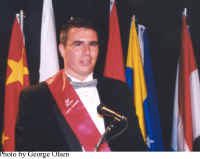
Jeff Rouse (USA)
Honor Swimmer (2001)
FOR THE RECORD: 1992 OLYMPIC GAMES: gold (4x100m medley relay), silver (100m backstroke); 1996 OLYMPIC GAMES: gold (100m backstroke, 4x100m medley relay); TWO WORLD RECORDS (L.C.): 4x100m medley relay, (S.C.): 100m backstroke; 1994 WORLD CHAMPIONSHIPS: gold (4x100m medley relay); silver (100m backstroke); 1996 PAN AMERICAN GAMES: gold (100m backstroke, 4x100m medley relay); FOUR U.S. NATIONAL CHAMPIONSHIPS: 1 (100y backstroke), 1 (100m backstroke), 2 (4x100m medley relay); SEVEN NCAA NATIONAL CHAMPIONSHIPS: 3 (100y backstroke), 1 (200y backstroke), 1 (4x5Oy, 4x100y medley relays), 1 (4x100y freestyle relay).
He loved to swim a lot of backstroke in practice, sometimes going 75% of the workout on his back. He became better in the 100m backstroke than the 200m backstroke, but as much time as he spent on his back, he never looked back when it came to achieving success. This slow talking, strong kicking swimmer became the number one ranked 100m backstroke swimmer in the world from 1989 through 1996. Only Hall of Famers Roland Matthes, Krisztina Egerszegi and Adolph Kiefer could claim the same 8-year dominance in this stroke. Along the way, Jeff Rouse won Olympic gold medals, set World Records, and captured World Championship titles. And he did it all with a confident but non-arrogant style, a reflection of his heart-warming character.
He began at age five in the Ferry Farm Appahannock Swim League where Jeff swam all strokes. The pool in Fredericksburg, Virginia, was only blocks from his house. At age nine, we moved to the Quantico Devil Dolphins under the coaching of Don Regenboghen. He set national age group records at age 11 and was Swimming World’s Age Group Swimmer of the month in 1983. By 1986, Jeff was chosen Rookie of the Meet at his first U.S. National Championships. After graduation from Stafford High School in 1988 and enrolling at Stanford, Jeff was on his way to international stardom.
His 6 feet 3 inch, 190-pound body was suited just right for swimming backstroke. Long and strong with powerful legs, he could kick 100 yards backstroke in 1:07 seconds. His belief was that if you concentrated on the proper stroke technique at all times, you would swim fast. And swim fast he did. In 1989, his first year at Stanford, he won the Pan Pacifics, 100m backstroke, the first of four Pan Pacific Championship gold medals in that event. He won the NCAA National Championship in the 200m backstroke and over the next three years he won a total of seven NCAA Championships.
His first backstroke World Record came in 1991 at the Edmonton Pan Pacific Championships. He and the world had watched David Berkoff set the World Record in 1988 at the Seoul Olympics swimming the 100m backstroke. Berkoff would go 33 meters dolphin kick underwater on his back at the start of the race and come up ahead of his opponents just before the first turn. This “Berkoff Blastoff” was much faster underwater than it was to swim on top of the water. After FINA changed the rules limiting the underwater kick to ten meters, Berkoff’s world record time of 54.51 appeared unbeatable. Rouse proved otherwise when he became the first person under 54 seconds for the 100m backstroke.
Jeff Rouse loved swimming. In his 1992 Olympic debut, he was out touched by Canadian and Hall of Famer Mark Tewksbury in the 100m back. Jeff declared that loss his catalyst to return in 1996 to win. He did. But in Barcelona, two days after winning the silver to Tewksbury, he won the gold in the 4x100m medley relay with teammates Nelson Diebel, Pablo Morales and Jon Olsen. Jeff helped set two World Records in that race, a relay record of 3:36.93 which stood for four years until his 1996 Atlanta gold medal Olympic team of Jeremy Linn, Mark Henderson and Gary Hall, Jr. broke it with a 3:34.8 and the 100m backstroke World Record of 53.86 as the lead-off swimmer in the relay. Both records stand today – 8-1/2 years later.
Rouse was captain of the USA 1996 Olympic team as well as his Stanford University team. Says Coach Skip Kenny, “Jeff leads by his work ethics and performance. He’s not a cheerleader, he does most of his talking one-on-one.” He is big on ethics, family and doing the right thing. He spearheaded a drive to put athlete’s integrity together by instituting random drug testing of all athletes. He talks to school groups and encourages young students to always try their hardest. He makes public appearances and works to promote the sport. He has appeared in a Sports Illustrated calendar and in numerous magazines.
